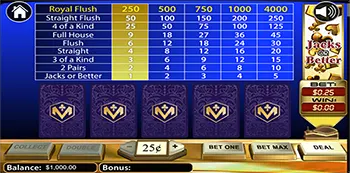Pay Attention to Video Poker Paytables & Game Payout Schedules
Paying attention to Video Poker Paytables and Game Payout schedules is the first step toward playing profitable video poker.
All video poker games are not the same
Many video poker players have little concept about what’s important when choosing a game. They assume all video poker games are essentially equal. But they’re not, and the pay schedules reveal this. Looking at and analyzing pay schedules tells which game has the smallest house edge, and that’s usually the one you should choose.
How do you read video poker schedules? It was a lot easier in the early days of video poker, when there were only a few base schedules. Today there are dozens. But certain principles still apply. The easiest way to demonstrate how schedules differ is to focus on a single game. Let’s use the granddaddy of video poker variations, Jacks or Better.
Be sure you understand the video poker paytables
Make sure you understand what the paytable are as you start to play. An example below of Jacks or Better video poker as played at Miami Club. Note if you bet more coins the potential payout is greater.
In a nutshell, the major difference in a Jacks or Better video poker game shows up in the payouts for the full house and the flush. The higher the combined payouts for these hands, the higher the machines return percentage. For example, all other payouts being equal, a Jacks or Better machine that pays nine coins for one for a full house and six for one for a flush is preferable to one that pays eight and five, seven and five, or six and five, respectively.
These two numbers in the middle of the schedule are so important; they’re used by players to identify machines. Players talk about “nine/six” machines or “eight/fives” or “seven/fives.” The nine/six version is also known as “full-pay,” because it’s the best you will commonly find.
To see it on the machine, look at the far left-hand row of listed payoffs, which are the returns for “one coin.” A nine/six schedule looks like this:
- 4-of-a-kind 25
- Full House 9
- Flush 6
- Straight 5
Results from a perfect played hand
Played perfectly, the long-term return of this video poker game is 99.5 percent, leaving a skinny .5 percent for the house. Over an average hour of quarter play, that works out to an expected loss of about $3.15. That’s some dirt cheap entertainment, especially considering that you’re downing free drinks along the way. Too cheap, in fact, which is why you won’t find a nine/six Jacks or Better in many places.
Casinos known for their good video poker have them (mostly locals joints, such as the “Palms” and both “Fiestas” in Las Vegas), but not many in other locations across the continent. The best Jacks or Better video poker games you will find there are usually the eight/fives and they look like this:
- 4-of-a-kind 25
- Full House 8
- Flush 5
- Straight 5
This slight variation might seem innocent enough, but playing this schedule jumps your average hourly loss to nearly $17! A seven/five game costs $24 per hour. And a six/five game, which is very common in bars, dings you a stunning $31 per hour to play. Do you see why paying attention to video poker game payout schedules is important?
Conclusion
The main point is that no matter where you play video poker take a look at the video poker paytables. Choosing the right machine and careful play can make all the difference.
If you prefer to play rtg (Spinlogic) video poker give the Uptown Aces casino a try. Or you may prefer Rival Gaming VP, if so Ducky Luck casino has fun Rival Video Poker.


